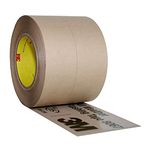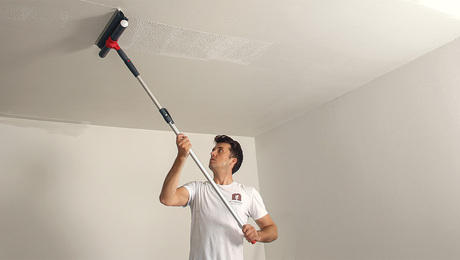Be careful with knife blades
Please don’t follow Mr. Carrasco’s advice for getting a new tip on a razor knife in his otherwise excellent article, “Cutting Drywall” (FHB #134, pp. 70-75). Razor knives and their blades are kind of like handguns in that along with their ownership comes responsibility.
Although I am no longer a carpenter, my hands still bear scars from 15 years at the trade. On the base of my right thumb, curving in a little crescent across the fleshy pad of my palm, is a 2-in. long scar inflicted when I ran my hand down a window’s rough opening and snagged the tip of a razor-knife blade that someone had snapped off between the jack and the stud.
Another time, I was horrified to see a guy on my crew changing out the blades in his knife. He dumped the four or five used, “dull” blades into the big gray trash can along with the floor sweepings, coffee cups, trim cutoffs and spent caulking tubes. I got a roll of duct tape from my truck and asked him to wrap the blades together with tape and a piece of cardboard before dropping them in the trash. Another guy used to slip his used blades into a soda can. Could be bad luck for the conscientious can recycler.
On my left middle finger is a slice alongside the nail from another razor-knife blade. I was repairing a leaky window on an almost-new oceanside house. Seems that the guy who shingled the house had slipped a “dull” blade up under a course of shingles, surely getting it out of his way but putting it right in mine.
Dull is a relative term. A dull razor-knife blade will still cut the heck out of your hand or your buddy’s. Tape your blades before you toss them.
—Jefferson Kolle, Ridgefield, CT
Design garages with snowplows in mind
I enjoyed reading the “Drawing Board” column devoted to the garage/house connection (FHB #134, pp. 40, 42, 44, 46), but I have one minor comment. I have yet to meet an architect who gives much thought to snow removal. The illustration showing a home where the garage faces the street isn’t particularly easy to plow. Even with a back plow, you’ll still have to drive over a pile of snow several times. If it’s wet snow, it may stick to the pavement and be hard to scrape up.
The 45° garage on p. 42 looks nearly impossible to plow well, with an excellent opportunity to destroy the front steps. The 90° garage on p. 44 is a snow plower’s dream, particularly if the pavement extends a little way beyond the last garage door and if there are no sprinkler heads lurking in the grass near the driveway. Come to think of it, sprinkler companies give less thought to snow removal than architects.
—Ed Trembly, via e-mail
Embrace restraint as a design principle
Alex Wilson’s article on environmentally conscious building strategies was utterly refreshing (FHB #133, pp. 92-97). Wilson correctly identifies the two paramount elements of “green” building: size and design. Small, efficiently designed houses not only require less material to build and consume less energy, but they also reflect and encourage a commitment to restraint. When we consciously restrain ourselves, we break the cycle of thoughtless consumption and develop more meaningful patterns for creating value in our lives. Emphasizing quality and care in our works is one such pattern.
Architectural restraint reminds us what a home is: shelter from the elements. The classic New England Cape or humble Southwestern adobe are both examples of the archetypal shelter. It reconnects us with the primordial need for coziness and comfort. When we build to meet such innate urgings and let go of frivolous motives, then class, good taste and charm exist inherently in our work, not superficially as stylistic add-ons. Higher levels of quality and care attend throughout the building process, as budgetary and time constraints relax in favor of superior workmanship.
Energy-efficient design is to a house what a sail is to a boat. Like a sailboat, a house can power itself primarily by harnessing natural forces. And just as a sailboat faces constraints that a powerboat does not, a passive-solar home must forgo spectacular views to the north and 18-ft. high cathedral ceilings. This is not a compromise. The constraints placed on sailboats by their engineering are precisely what make them such elegant vessels.
Without the guiding principle of restraint, we blur the line between elegance and tawdriness. We lose something sacred when we separate functionality and efficiency from aesthetic appeal and think of them as competing interests. The beauty and simplicity of a sailboat impacts us viscerally. Our homes can do the same.
—Jeff Chapman, Crestone, CO
Renovation is recycling
Great article on green building in your August/September issue (FHB #133, pp. 92-97). However, the author failed to mention a technique that has the lowest impact on the environment: renovating an old house. This may not seem apparent, with the Dumpsters in the front yard and the new lumber being brought in the front door, but the overall impact on the environment is far less than new construction. And most important, you’re reducing suburban sprawl. This is the ultimate in recycling.
—Michael Chiarella, via e-mail
Don’t be so quick to judge those SUV drivers
Great article, “Inexpensive Strategies for Green Building” by Alex Wilson, in your August/September issue (FHB #133, pp. 92-97). It helped me better understand green-building practices. However, the graphic on p. 92 showing the “wasteful habit” house stretches the bounds of green building. The caption at the garage reads, “Three-car garage with extra SUVs may indicate excessive consumption.” Since when does driving an SUV have anything to do with green building? (Besides, that three-car garage may be a workshop for a self-employed entrepreneur who saves gas by working at home.) We should educate people on the importance of building green, but we shouldn’t pass judgment on those who don’t.
—David Getts, Bothell, WA
Service can be hard to find with geothermal systems
As the owner of a home with a geothermal heating and cooling system, I agree with nearly everything Mr. Evangelist put in his article (FHB #133, pp. 104-109). However, I caution potential buyers to consider maintenance of the system before buying. I own a WaterFurnace system, just as Mr. Evangelist supplies, and have had poor experience getting the system serviced. The dealer who installed the system received special help from WaterFurnace for the installation but never became fully involved in geothermal systems. The WaterFurnace people said that many HVAC dealers became involved with geothermal systems a few years ago when electric companies were offering rebates on the systems, but most bailed when the rebates ended.
Thus I’m stuck with an HVAC system where the nearest qualified service technician—with special equipment such as the flush cart—is 150 miles away. Service calls are outrageously expensive. I tried using local technicians, but most do not want to work on the system. And of course, none has the special equipment. I’ve tried getting simple troubleshooting information directly from WaterFurnace, but they won’t talk to me because I’m not an HVAC technician. I’m hoping to make the system last a few more years, and then I’ll replace it with a conventional HVAC system.
—Dan Snavely, Binghamton, NY
Let the widows walk
I would like to respond to John Spier’s reply in “Widow’s walks” (FHB #133, “Q&A,” p. 26). Although he makes some excellent suggestions, I disagree with his favoritism toward cupolas and balconies. He says: “Most people today recognize widow’s walks for the sunbaked, windswept anachronisms that they are. The same needs can be much better addressed with a cupola or a balcony, also traditional and attractive but much more functional.” Although cupolas (which, by the way, are also relics of the past) seem to be making a comeback in just about every new-home design today, they do not provide the size and openness of a widow’s walk. Balconies are great, too, but they don’t offer the roof-top experience.
Mr. Spier states, “… by code the railings have to be at least 36 in. high, which would make your widow’s walk look more like the OK Corral on top of any but the largest houses.” I recently built a modestly sized home in Rhode Island that features a very prominent widow’s walk. The widow’s walk is actually perched atop a roof-level office, making the floor of the widow’s walk roughly at the same height as the ridge. Instead of using a tall railing, the walk features solid walls with a 6-in. decorative railing all around and a section of 2-ft. rail in the front. The height to the top rail is actually 42 in. rather than 36 in., giving the roof dwellers an enhanced sense of security and privacy. Far from resembling the OK Corral, the design is neat and attractive, incorporating the “solid and void” concept common to many shingle-style homes.
The 12-ft. by 12-ft. feature affords a picturesque view of Narragansett Bay that would not have been possible without the deck’s height. The widow’s walk is the perfect place for entertaining, watching the sunset or relaxing with a glass of wine. I would consider putting one on any new home I designed.
—Dan Freitas, Jamestown, RI
Steel roofing won’t last forever
Just a couple of reactions to the article on steel roofing (FHB #134, pp. 98-104). I wouldn’t characterize steel as a lifetime roofing material. Even terne-coated stainless, copper or zinc is good only for around 70 years to 100 years. Typically, the finish on top-quality steel roofing is good for 20 years and the panels for another 20. I would hope most buildings would last more than 40 years.
Regarding fire resistance, yes, steel itself will not catch from falling embers. If a large burning limb falls onto the roof, however, the structure is liable to heat up enough through the metal to ignite the structure inside. Some cheap additional insurance is a layer of Dens-Deck (silicone-impregnated, fiberglass-faced type-X gypsum panels, made by Georgia-Pacific Corp.; 800-284-5347) above the plywood. This is a commonly specified commercial assembly, and the materials are not particularly expensive or difficult to work with.
—Thomas Allen, San Francisco, CA
Rubber boot around a flue pipe is a code violation
After reading the article “Installing Steel Roofing” in your recent issue (FHB #134, pp. 98-104), I noticed a major code violation, at least for Ohio. The author installed a rubber boot around a B-vent gas flue pipe. Most of these pipes clearly state that they require a minimum of 1-in. clearance to all combustible materials, rubber being one of them. In the photo on p. 101, you can see the sticker that probably has these requirements written on them. Why would he put a regular storm collar on the furnace flue B-vent but not on the other?
—Richard White, via e-mail
John La Torre Jr. replies: Mr. White is right. This rubber roof jack is not approved for use on a B-vent gas pipe. The manufacturer rates the rubber for up to 250°F sustained contact. Exhaust gas from a water heater can reach 480°F.
So why do I use this roof jack on a B-vent? Because it works. When the water heater is in operation, the outside wall of the B-vent is hot to the touch only near the joints. Away from the joints, the pipe is not too hot to touch.
Five years ago, I installed one of these rubber roof jacks on a B-vent over a water heater. Today, that rubber is still as flexible as when it was new. Do I recommend that others use rubber roof jacks on B-vents? No, I cannot. As Mr. White pointed out, it doesn’t meet code.
Cover raises safety concerns
I would like to take issue with two things on the cover of FHB #130. First and foremost, although many tool makers provide a hammer holster in the back of a tool belt, this is not a safe spot for the hammer. If you fall backward, even off a stoop, the hammer can swing out and provide a fulcrum to snap your back. I worked with an excellent carpenter who convinced almost everyone to switch to a side holster. He had been a lineman, and those guys insist on it.
Less critical, but still important: There is no snubber (or brace) to prevent the wall from going over the edge and taking everyone with it. A gust of wind or an overeager push, and down goes the crew. Why risk it?
—Dave Bainbridge, La Jolla, CA
A clarification about Ultra-Flex
In our write-up on Ultra-Flex rigid drywall tape (FHB #134, p. 130), we incorrectly listed Grabber Construction Products as the manufacturer. In fact, Ultra-Flex is made by Drywall Systems International and is sold under the brand name No-Coat. Grabber is the distributor.
—The editors
Fine Homebuilding Recommended Products
Fine Homebuilding receives a commission for items purchased through links on this site, including Amazon Associates and other affiliate advertising programs.

Affordable IR Camera

8067 All-Weather Flashing Tape

Reliable Crimp Connectors


















